Reading time: 12 min
A long time ago there lived a king who was famed for his wisdom through all the land. Nothing was hidden from him, and it seemed as if news of the most secret things was brought to him through the air. But he had a strange custom; every day after dinner, when the table was cleared, and no one else was present, a trusty servant had to bring him one more dish. It was covered, however, and even the servant did not know what was in it, neither did anyone know, for the King never took off the cover to eat of it until he was quite alone.
This had gone on for a long time, when one day the servant, who took away the dish, was overcome with such curiosity that he could not help carrying the dish into his room. When he had carefully locked the door, he lifted up the cover, and saw a white snake lying on the dish. But when he saw it he could not deny himself the pleasure of tasting it, so he cut off a little bit and put it into his mouth.
No sooner had it touched his tongue than he heard a strange whispering of little voices outside his window. He went and listened, and then noticed that it was the sparrows who were chattering together, and telling one another of all kinds of things which they had seen in the fields and woods. Eating the snake had given him power of understanding the language of animals.
Now it so happened that on this very day the Queen lost her most beautiful ring, and suspicion of having stolen it fell upon this trusty servant, who was allowed to go everywhere. The King ordered the man to be brought before him, and threatened with angry words that unless he could before the morrow point out the thief, he himself should be looked upon as guilty and executed.
In vain he declared his innocence. He was dismissed with no better answer. In his trouble and fear he went down into the courtyard and took thought how to help himself out of his trouble. Now some ducks were sitting together quietly by a brook and taking their rest; and, whilst they were making their feathers smooth with their bills, they were having a confidential conversation together. The servant stood by and listened. They were telling one another of all the places where they had been waddling about all the morning, and what good food they had found, and one said in a pitiful tone, „Something lies heavy on my stomach; as I was eating in haste I swallowed a ring which lay under the Queen’s window.“
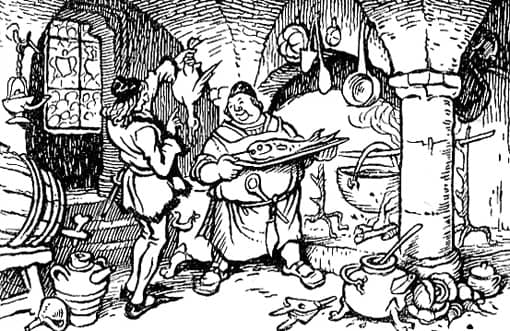
The servant at once seized her by the neck, carried her to the kitchen, and said to the cook, „Here is a fine duck. Pray, kill her.“ – „Yes,“ said the cook, and weighed her in his hand. „She has spared no trouble to fatten herself, and has been waiting to be roasted long enough.“ So he cut off her head, and as she was being dressed for the spit, the Queen’s ring was found inside her. The servant could now easily prove his innocence.
And the King, to make amends for the wrong, allowed him to ask a favour, and promised him the best place in the court that he could wish for. The servant refused everything, and only asked for a horse and some money for travelling, as he had a mind to see the world and go about a little. When his request was granted he set out on his way, and one day came to a pond, where he saw three fishes caught in the reeds and gasping for water.

Now, though it is said that fishes are dumb, he heard them lamenting that they must perish so miserably, and, as he had a kind heart, he got off his horse and put the three prisoners back into the water. They quivered with delight, put out their heads, and cried to him, „We will remember you and repay you for saving us!“ He rode on, and after a while it seemed to him that he heard a voice in the sand at his feet. He listened, and heard an ant-king complain, „Why cannot folks, with their clumsy beasts, keep off our bodies? That stupid horse, with his heavy hoofs, has been treading down my people without mercy!“ So he turned on to a side path and the ant-king cried out to him, „We will remember you – one good turn deserves another!“
The path led him into a wood, and here he saw two old ravens standing by their nest, and throwing out their young ones. „Out with you, you idle, good-for-nothing creatures!“ cried they. „We cannot find food for you any longer. You are big enough, and can provide for yourselves.“ But the poor young ravens lay upon the ground, flapping their wings, and crying, „Oh, what helpless chicks we are! We must shift for ourselves, and yet we cannot fly! What can we do, but lie here and starve?“ So the good young fellow alighted and killed his horse with his sword, and gave it to them for food.
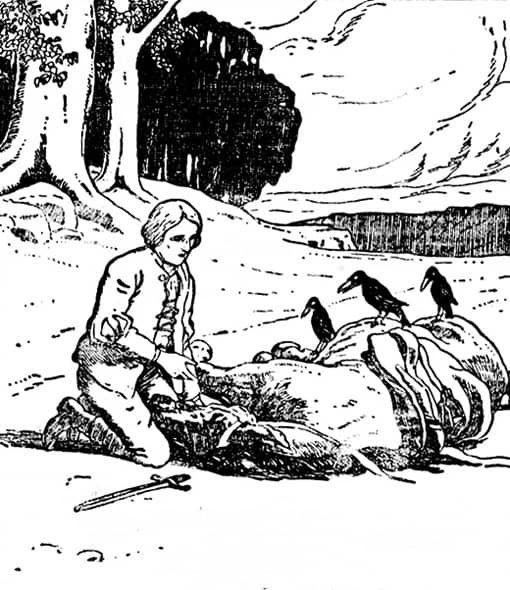
Then they came hopping up to it, satisfied their hunger, and cried, „We will remember you – one good turn deserves another!“ And now he had to use his own legs, and when he had walked a long way, he came to a large city. There was a great noise and crowd in the streets, and a man rode up on horseback, crying aloud, „The King’s daughter wants a husband; but whoever sues for her hand must perform a hard task, and if he does not succeed he will forfeit his life.“ Many had already made the attempt, but in vain. Nevertheless when the youth saw the King’s daughter he was so overcome by her great beauty that he forgot all danger, went before the King, and declared himself a suitor.
So he was led out to the sea, and a gold ring was thrown into it, in his sight. Then the King ordered him to fetch this ring up from the bottom of the sea, and added, „If you come up again without it you will be thrown in again and again until you perish amid the waves.“ All the people grieved for the handsome youth. Then they went away, leaving him alone by the sea. He stood on the shore and considered what he should do, when suddenly he saw three fishes come swimming towards him, and they were the very fishes whose lives he had saved.
The one in the middle held a mussel in its mouth, which it laid on the shore at the youth’s feet, and when he had taken it up and opened it, there lay the gold ring in the shell. Full of joy he took it to the King, and expected that he would grant him the promised reward. But when the proud princess perceived that he was not her equal in birth, she scorned him, and required him first to perform another task. She went down into the garden and strewed with her own hands ten sacks-full of millet-seed on the grass. Then she said, „To-morrow morning before sunrise these must be picked up, and not a single grain be wanting.“
The youth sat down in the garden and considered how it might be possible to perform this task, but he could think of nothing, and there he sat sorrowfully awaiting the break of day, when he should be led to death. But as soon as the first rays of the sun shone into the garden he saw all the ten sacks standing side by side, quite full, and not a single grain was missing. The ant-king had come in the night with thousands and thousands of ants, and the grateful creatures had by great industry picked up all the millet-seed and gathered them into the sacks.
Presently the King’s daughter herself came down into the garden, and was amazed to see that the young man had done the task she had given him. But she could not yet conquer her proud heart, and said, „Although he has performed both the tasks, he shall not be my husband until he has brought me an apple from the Tree of Life.“ The youth did not know where the Tree of Life stood, but he set out, and would have gone on for ever, as long as his legs would carry him, though he had no hope of finding it.
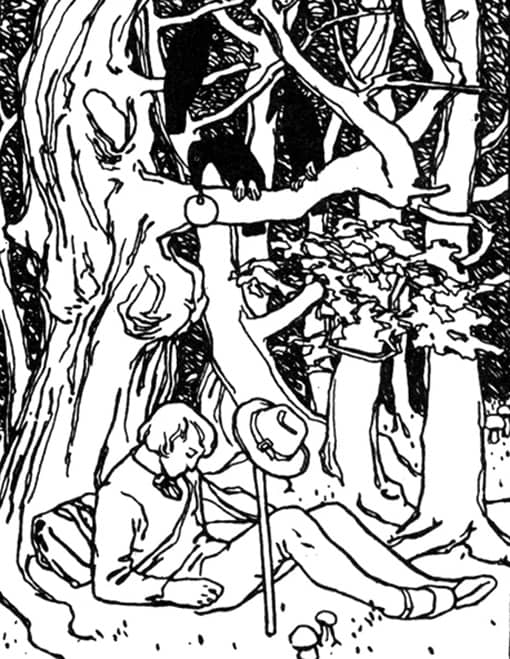
After he had wandered through three kingdoms, he came one evening to a wood, and lay down under a tree to sleep. But he heard a rustling in the branches, and a golden apple fell into his hand. At the same time three ravens flew down to him, perched themselves upon his knee, and said, „We are the three young ravens whom you saved from starving. When we had grown big, and heard that you were seeking the Golden Apple, we flew over the sea to the end of the world, where the Tree of Life stands, and have brought you the apple.“
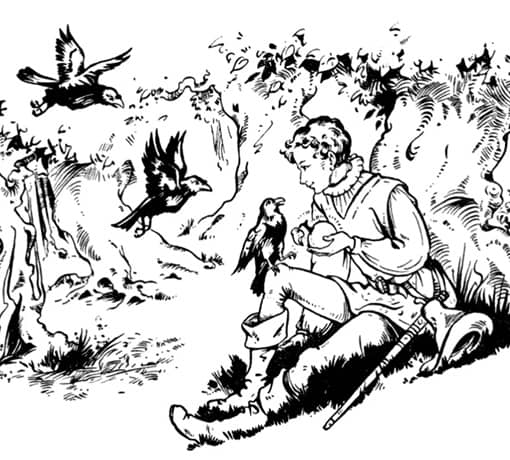
The youth, full of joy, set out homewards, and took the Golden Apple to the King’s beautiful daughter, who had no more excuses left to make. They cut the Apple of Life in two and ate it together; and then her heart became full of love for him, and they lived in undisturbed happiness to a great age.
 Learn languages. Double-tap on a word.Learn languages in context with Childstories.org and Deepl.com.
Learn languages. Double-tap on a word.Learn languages in context with Childstories.org and Deepl.com.Backgrounds
Interpretations
Adaptions
Summary
Abstract
Linguistics
„The White Snake“ is a fairy tale collected by the Brothers Grimm, featured in their famous anthology „Grimm’s Fairy Tales.“ The story has its roots in various aspects contributing to its background: Like many other tales in the Grimm’s collection, „The White Snake“ originated from the oral tradition of storytelling. Passed down through generations by word of mouth, the story was eventually documented and published by the Brothers Grimm.
The Brothers Grimm were fascinated by folklore, myths, and legends and sought to preserve traditional German stories. They collected stories from various sources, including oral narratives, manuscripts, and early printed books, and then compiled, edited, and published them. The tales often contain moral lessons and values, reflecting the culture and beliefs of the time. The story is an example of German folklore and features characters, settings, and themes typical of tales from the region. The Brothers Grimm sought to preserve the cultural heritage of Germany by collecting and publishing stories like „The White Snake.“ „The White Snake“ contains several common folk motifs found in fairy tales across different cultures. These include the magical helper, the hero’s quest, the trial of tasks, and the use of supernatural powers or knowledge to overcome obstacles.
Jacob and Wilhelm Grimm were German academics, linguists, and cultural researchers who dedicated themselves to collecting and preserving the folktales of their country. Their work was part of the broader Romantic movement, which aimed to reclaim and elevate traditional folk culture. „The White Snake“ shares similarities with other folktales that feature talking animals, magical objects, and heroes who must complete a series of tasks to achieve their goals. The exchange of stories between different cultures and regions may have influenced the development and evolution of these tales.
The stories in the Grimm’s collection have had a significant impact on literature and popular culture, inspiring countless adaptations, reinterpretations, and artistic works. „The White Snake“ is one such example, showcasing themes of kindness, wisdom, perseverance, and the interconnectedness of all beings. While not as well-known as some of the other tales in the collection, such as „Cinderella,“ „Snow White,“ or „Hansel and Gretel,“ „The White Snake“ remains an important piece of European folklore with enduring relevance and charm.
In summary, „The White Snake“ has its origins in the oral storytelling tradition and German folklore. Collected by the Brothers Grimm as part of their efforts to preserve the cultural history of their country, the story includes common folk motifs and shares elements with other tales, contributing to its rich background and enduring appeal.
„The White Snake“ is a fairy tale collected by the Brothers Grimm that can be interpreted in various ways, offering readers different perspectives on its themes and messages:
The power of kindness and compassion: The servant’s willingness to help animals in need results in their assistance during his time of need. This theme demonstrates the importance of being kind and compassionate to others, regardless of their status or species, as it can lead to unexpected rewards and positive outcomes.
The value of wisdom and understanding: The white snake grants the servant the power to understand the language of animals, leading to wisdom and insight that ultimately helps him complete the seemingly impossible tasks. This theme highlights the importance of knowledge and understanding in overcoming obstacles and achieving success.
The dangers of pride and prejudice: The princess initially refuses to marry the servant due to his lower social status, despite his accomplishments. However, she ultimately changes her mind after sharing the apple from the Tree of Life. This theme serves as a reminder of the dangers of judging others based on superficial factors and the importance of recognizing one’s own pride and prejudice.
The power of perseverance and determination: The servant’s unwavering determination to complete the tasks and win the princess’s hand showcases the importance of never giving up, even in the face of adversity. His perseverance eventually leads him to find love and happiness, demonstrating that persistence can bring about positive change.
The interconnectedness of all beings: The story emphasizes the interconnectedness of all living beings and the idea that actions have consequences. The servant’s actions positively impact the lives of the animals he encounters, and they repay his kindness by helping him in his time of need. This theme highlights the importance of treating others with kindness, as their well-being is interconnected with our own.
The quest for knowledge: The story can be seen as an exploration of the pursuit of knowledge and its potential consequences. The protagonist gains access to the white snake’s wisdom, allowing him to understand animals and the world around him in a way that others cannot. The tale raises questions about the value of knowledge and the responsibilities that come with it.
Good deeds and their rewards: The protagonist’s kindness towards animals is rewarded with assistance in completing the difficult tasks set before him. This interpretation emphasizes the importance of compassion and empathy, suggesting that kindness towards others—even non-human creatures—can lead to positive outcomes.
Overcoming obstacles: Like many fairy tales, „The White Snake“ tells the story of a hero who must face and overcome various challenges. The protagonist’s resilience, resourcefulness, and determination are key to his success, highlighting the value of perseverance and adaptability in the face of adversity.
The power of transformation: The tale demonstrates the transformative power of experiences and relationships. The protagonist’s encounter with the white snake and his interactions with the animals he helps lead him on a journey of self-discovery and growth. By the end of the story, he has evolved from a humble servant to a wise and respected king.
Social mobility: „The White Snake“ also addresses the theme of social mobility. The protagonist, who begins the story as a lowly servant, is able to rise through the ranks and become king due to his virtues and abilities. This aspect of the tale reflects the idea that hard work, determination, and good character can allow individuals to transcend their social status.
The role of fate and destiny: The story touches on the concepts of fate and destiny, as the protagonist’s life is changed dramatically by seemingly chance encounters. The white snake, the animals he befriends, and the princess he ultimately marries all play a crucial role in shaping his future, suggesting that destiny can be influenced by both personal choices and external forces.
Overall, „The White Snake“ offers a range of interpretations, exploring themes such as the pursuit of knowledge, the importance of kindness, overcoming obstacles, personal transformation, social mobility, and the role of fate and destiny.
„The White Snake“ is a German fairy tale collected by the Brothers Grimm, who were linguists, cultural researchers, and authors. Jacob and Wilhelm Grimm published the story in their collection „Kinder- und Hausmärchen“ (Children’s and Household Tales) in 1812. The collection, also known as „Grimm’s Fairy Tales,“ has become one of the most famous and influential works of folklore in the Western world. While „The White Snake“ may not be as widely adapted as some other Grimm’s fairy tales, there are still several adaptations of the story in various formats:
Films: „The White Snake“ film by Wolfgang E. Struck: In 1954, Wolfgang E. Struck directed a German film adaptation of „The White Snake.“ The film follows the story of a young servant who gains the ability to understand the language of animals and uses it to help a king solve a mystery and win the hand of his daughter.
Children’s books: The story has been adapted into illustrated children’s books, which often simplify the plot for a younger audience. One example is „The White Snake: A Tale from the Brothers Grimm“ by M. Charlotte Craft, which features illustrations by K.Y. Craft. „The White Snake“ graphic novel by Jacob and Wilhelm Grimm: In 2015, Image Comics published a graphic novel adaptation of „The White Snake,“ featuring illustrations by Joëlle Jones. The graphic novel stays true to the original story, with some minor tweaks to the dialogue and characterizations.
Animated adaptations: The fairy tale has been adapted into animated shorts and TV episodes, such as the 1980s German animated series „Grimm’s Fairy Tale Classics.“ The series retold various fairy tales, including „The White Snake,“ in a format suitable for children. „The White Snake“ animated short film by Disney: In 2011, Disney released an animated short film adaptation of „The White Snake“ as part of their „Tangled Ever After“ series. The short follows the adventures of Rapunzel and Eugene as they try to retrieve the wedding rings of the kingdom’s royals, which have been stolen by Pascal and Maximus.
Theater productions: „The White Snake“ has been included in theatrical productions, often adapted for the stage as a play or musical. In some cases, it may be combined with other fairy tales to create a larger, more intricate performance. „The White Snake“ ballet by John Neumeier: In 2012, the Hamburg Ballet premiered a ballet adaptation of „The White Snake,“ choreographed by John Neumeier. The ballet combines elements of Chinese and European culture and features music by Lera Auerbach.
Audio recordings: The story has been adapted into audio formats, such as audiobooks and radio dramas, making it accessible to those who prefer listening to stories. For instance, „The White Snake“ has been included in collections of Brothers Grimm stories, narrated by various voice actors. „The White Snake“ opera by Wolfgang Amadeus Mozart: In 1790, Mozart composed an opera based on the Brothers Grimm tale. The opera follows the story of a prince who gains the ability to understand the language of animals and uses it to solve a mystery.
Educational materials: „The White Snake“ can be found in educational materials that focus on teaching students about folktales, fairy tales, or the Brothers Grimm. These materials may include adaptations of the story, as well as related activities and lessons to help students explore the themes and messages of the tale.
While „The White Snake“ may not have been adapted as extensively as some of the more popular Grimm’s fairy tales, it still offers a unique and engaging narrative that has inspired various adaptations in books, animation, theatre, audio recordings, and educational materials. These adaptations demonstrate the enduring popularity and versatility of „The White Snake“ as a fairy tale. From opera to graphic novels, filmmakers and artists have found new ways to interpret and reimagine this classic story.
„The White Snake“ is a fairy tale collected by the Brothers Grimm about a young servant who gains the ability to understand animals after tasting a magical white snake. The protagonist uses this newfound wisdom to complete a series of tasks and ultimately wins the hand of a princess. The story begins with a king who has a mysterious ritual: every day, a covered dish is brought to him, and no one knows what it contains. The young servant becomes curious and uncovers the dish, finding a white snake inside. He tastes a small piece of the snake and suddenly gains the ability to understand the language of animals.
One day, the queen loses a valuable ring, and the king suspects the servant of stealing it. To prove his innocence, the servant is given the task of finding the ring within three days or face execution. With his newfound ability to communicate with animals, the servant enlists the help of some ducks, one of which has swallowed the ring. The duck is caught, the ring is retrieved, and the servant is spared.
Impressed by the servant’s resourcefulness, the king gives him a more challenging task: to retrieve a golden apple from a faraway tree. Along the way, the servant helps various animals—a fish, an ant, and a raven—which promise to return the favor. With their assistance, the servant successfully retrieves the golden apple and brings it back to the king.
The king, still not satisfied, presents the servant with one final task: to bring back a beautiful princess from a distant kingdom. The servant, along with the raven, travels to the princess’s kingdom and proposes the king’s offer. The princess agrees, but only if the servant can correctly identify her among three identical women after she has switched places with her maids. The servant calls upon the ant he had helped earlier, which recognizes the princess by a small mark on her neck. The servant identifies the true princess, and they return to his kingdom.
In the end, the king fulfills his promise, and the servant marries the princess, eventually becoming king himself. The story of „The White Snake“ showcases themes of wisdom, kindness, and the power of friendship, as the protagonist overcomes various challenges and rises to greatness with the help of the animals he had shown kindness to.
„The White Snake“ is a fairy tale by the Brothers Grimm about a king with a mysterious daily ritual and a servant who gains the ability to understand the language of animals. The king eats a secret dish containing a white snake, which the curious servant eventually tastes, gaining the ability to understand animals. The servant is accused of stealing the queen’s ring, but with the help of animals, he proves his innocence.
The king allows the servant to ask for a favor, and the servant chooses to travel the world. On his journey, he helps various animals, who in turn promise to help him in the future. When the servant arrives at a city, he learns that the king’s daughter will marry the man who can accomplish a difficult task. The man falls in love with the princess and attempts the task.
With the help of the animals he saved, the servant completes several tasks, including retrieving a gold ring from the sea, gathering millet seeds, and finding an apple from the Tree of Life. The princess, initially too proud to accept him, eventually falls in love with the servant after sharing the apple. The couple lives in happiness, and the servant’s kindness and perseverance are rewarded.
The fairy tale „The White Snake“ by the Brothers Grimm offers a rich tapestry for linguistic analysis, with themes of curiosity, wisdom, loyalty, and reward. It combines elements of magic, folk motifs, and moral lessons typical of Grimm tales. Here are some key linguistic and thematic aspects to consider:
Narrative Structure
Exposition: The story starts by introducing a wise king with a peculiar habit, setting up an air of mystery around the dish with the white snake.
Rising Action: The servant’s curiosity leads him to taste the snake, gifting him the ability to understand animals.
Climax: The servant faces a near-death challenge of proving his innocence regarding the queen’s lost ring.
Falling Action: The animals the servant helps repay his kindness, assisting him in completing tasks set by the king’s daughter.
Resolution: The servant marries the princess, completing his journey from a humble servant to royalty.
Formal Language: The text uses formal and somewhat archaic language, reflecting its origins and enhancing the tale’s timeless quality. Words like „sue“ (to court) and „forfeit“ infuse a sense of medieval gravitas.
Repetition: This technique emphasizes key narrative points and aids memorability, crucial in oral storytelling traditions. The phrase „one good turn deserves another“ encapsulates the protagonist’s helpful nature and is iterated through different animal characters.
Dialogue: Conversational exchanges, particularly between animals, reveal character traits and advance the plot. For example, the ducks and ravens highlight the servant’s kindheartedness and its rewards.
Thematic Elements
Wisdom and Curiosity: The narrative explores the tension between these two traits. The king’s wisdom is linked to secrecy, while the servant’s curiosity, initially portrayed as dangerous, eventually leads to his success.
Understanding Animals: The servant’s magical ability to comprehend animals symbolizes insight and empathy, allowing him to navigate and resolve challenges.
Moral Reciprocity: The tale’s moral centers on kindness reciprocated, a common motif in folklore. The protagonist’s benevolence towards animals results in their assistance during his trials.
Symbolism
The White Snake: Represents mystery and the source of wisdom. In various cultures, snakes are symbols of knowledge or transcendence.
The Golden Apple: A universal symbol of temptation, reward, and immortality ties back to mythological elements like the Garden of the Hesperides.
Character Analysis
The Servant: Starts as a curious yet dutiful figure, whose journey transforms him into a noble and compassionate hero, rewarded for his virtues.
The Animals: Act as conveyors of wisdom and justice, bridging human and animal worlds, their language revealing hidden knowledge.
The Princess: Her initial pride and eventual change of heart reflect transformative love and the breaking of social barriers.
In essence, „The White Snake“ encapsulates the Brothers Grimm’s narrative style, where magical elements woven with moral lessons create an engaging and instructive tale. The linguistic style supports its function as both entertainment and moral instruction, with its intricate interplay of character, dialogue, and thematic richness.
Information for scientific analysis
Fairy tale statistics | Value |
|---|---|
| Number | KHM 17 |
| Aarne-Thompson-Uther-Index | ATU Typ 673 |
| Translations | DE, EN, DA, ES, FR, PT, HU, IT, JA, NL, PL, RU, VI, ZH |
| Readability Index by Björnsson | 35.5 |
| Flesch-Reading-Ease Index | 76 |
| Flesch–Kincaid Grade-Level | 8.5 |
| Gunning Fog Index | 11.1 |
| Coleman–Liau Index | 7.9 |
| SMOG Index | 9.1 |
| Automated Readability Index | 9.2 |
| Character Count | 8.403 |
| Letter Count | 6.501 |
| Sentence Count | 69 |
| Word Count | 1.612 |
| Average Words per Sentence | 23,36 |
| Words with more than 6 letters | 195 |
| Percentage of long words | 12.1% |
| Number of Syllables | 2.042 |
| Average Syllables per Word | 1,27 |
| Words with three Syllables | 71 |
| Percentage Words with three Syllables | 4.4% |
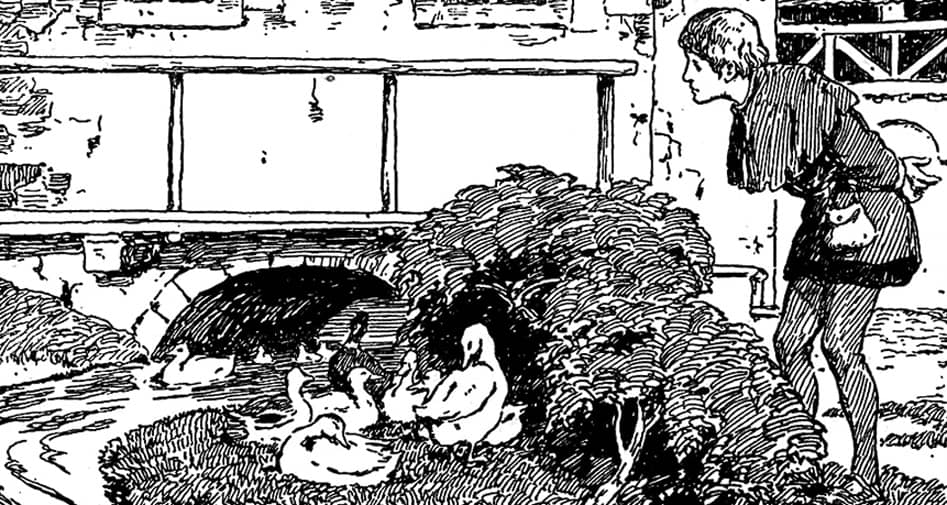
 Facebook
Facebook  Whatsapp
Whatsapp  Messenger
Messenger  Telegram
Telegram Reddit
Reddit














